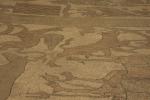Cathedral of the Martyrs - Otranto
Mid Tuesday afternoon (24th May) we left Lecce for fifty-minute coach journey to Otranto, and a look around the cathedral which was consecrated in 1088. It is a fine example of Romanesque architecture with Byzantine and Baroque influences. Its façade is quite simple yet imposing, and is enriched by a beautiful 15th-century Gothic-Arabic rose window, which was further decorated in Baroque style in 1674.
The bell tower was built in the 12th century, adds another element of interest to the building.
Inside, the central nave and the two side aisles are separated by granite columns with capitals of different styles, creating a majestic and solemn atmosphere. The golden wooden ceiling is particularly interesting in a particular Moorish style, also and the precious high altar with the 18th-century silver antependium.
The Floor mosaics are particularly interesting, created by the monk Pantaleone between 1163 and 1165. This mosaic, which extends throughout the central nave, the transept, and the apse, depicts biblical and medieval scenes, including the famous "Tree of Life".It is one of the largest and best-preserved medieval mosaics in Europe.
Another interesting part of the cathedral was the Chapel of the Martyrs, which houses the bones of the residents of Otranto who were killed by the Ottomans in 1480 for refusing to renounce their faith. This chapel, located at the end of the right aisle, is a place of intense spirituality and reflection.
|













